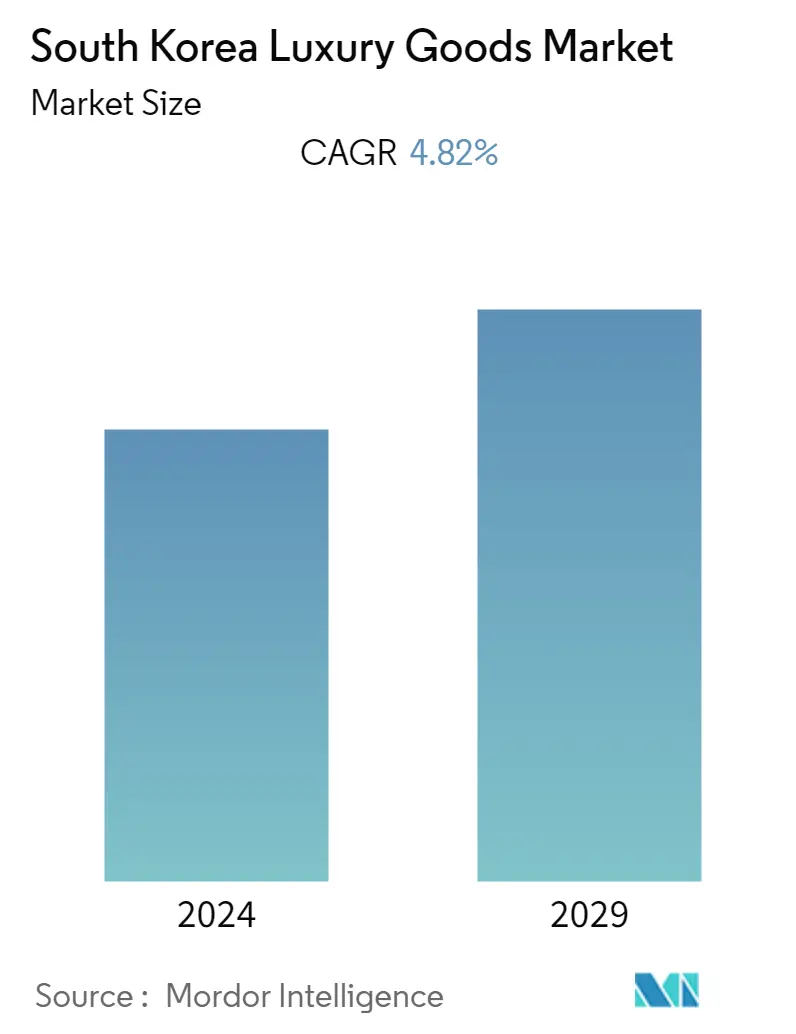Market Size of South Korea Luxury Goods Industry

| Study Period | 2019 - 2029 |
| Base Year For Estimation | 2023 |
| Forecast Data Period | 2024 - 2029 |
| Historical Data Period | 2019 - 2022 |
| CAGR | 4.82 % |
| Market Concentration | Low |
Major Players
*Disclaimer: Major Players sorted in no particular order |
South Korea Luxury Goods Market Analysis
The South Korea luxury goods market is projected to register a CAGR of 4.82 % during the forecast period, 2022-2027.
A major share of revenue generated by luxury goods in South Korea came from brick-and-mortar shops in the pre-pandemic era. After the rapid spread of the coronavirus in 2020, the country faced lockdowns, and hence, the closure of shops including specialty stores and other luxury goods stores adversely affected the high-end products market in South Korea. However, the halt in sales due to the pandemic allowed the companies to plan and diversify their distribution strategies as they understood the drawbacks of using brick and mortar as the main sales channel with the commencement of COVID-19.
The players in the market began to narrow the buyer-seller divide, and the majority of the players began establishing their digital channels in 2021 to sustain themselves in the market in long run. For instance, in April 2021, Shinsegae Group, South Korea's largest retail group launched an e-commerce platform called SSG.com to market luxury goods. Additionally, online channels have helped in the post-pandemic sales recovery in South Korea's luxury goods market.
In the medium term, the market growth can be attributed to the rising number of online shoppers as consumers now easily obtain product-related information and prices online due to the growth of e-commerce. Different celebrities like K-pop stars have a huge influence on the young population in the region. Hence, the promotion and advertisements of luxury goods featuring such celebrities also help in driving the luxury goods market in South Korea. Consumers in South Korea are quite selective when it comes to their purchases of high-end products, such as cosmetics and fragrances. As a result, the businesses competing in the market are enhancing their ecological packaging designs.
South Korea Luxury Goods Industry Segmentation
As per the study scope, luxury goods refer to high-end or premium products like luxury watches, luxury footwear, luxury clothing, apparel, and other such products that are of superior quality and are priced higher than other goods available in the market. South Korea luxury goods market is segmented by type and distribution channel. By type, the market is segmented into clothing and apparel, footwear, bags, jewelry, watches, and other accessories. In terms of distribution channels, the market is segmented into single-brand stores, multi-brand stores, online stores, and other distribution channels. The report offers market size and forecasts for the luxury goods market in value (USD million) for all the above segments.
| By Type | |
| Clothing and Apparel | |
| Footwear | |
| Bags | |
| Watches | |
| Jewelry | |
| Watches | |
| Other Accessories |
| By Distibution Channel | |
| Single-Brand Stores | |
| Multi-Brand Stores | |
| Online Stores | |
| Other Distribution Channels |
South Korea Luxury Goods Market Size Summary
The South Korea luxury goods market is experiencing a transformation driven by the shift from traditional brick-and-mortar stores to digital platforms. The pandemic highlighted the vulnerabilities of relying solely on physical retail spaces, prompting companies to enhance their online presence. This shift has been supported by the increasing number of online shoppers who prefer the convenience and accessibility of e-commerce. The influence of K-pop celebrities in promoting luxury brands has further fueled this trend, as these figures resonate strongly with the youth-driven culture in South Korea. Brands like Celine, Prada, and Louis Vuitton have leveraged celebrity endorsements to create aspirational lifestyles, thereby boosting their market presence.
The market is characterized by a fragmented landscape with both domestic and international players vying for consumer attention. Companies are employing various strategies such as partnerships, product launches, and targeted advertising to strengthen their market position. The adoption of innovative technologies, like virtual try-ons, has enhanced the online shopping experience, making it more appealing to younger consumers. Major players in the market, including Prada, LVMH, and Chanel, continue to expand their footprint through strategic initiatives. The growing preference for online retail, coupled with the influence of digital media, is expected to sustain the market's growth trajectory in the coming years.
South Korea Luxury Goods Market Size - Table of Contents
-
1. MARKET DYNAMICS
-
1.1 Market Drivers
-
1.2 Market Restraints
-
1.3 Porter's Five Force Analysis
-
1.3.1 Threat of New Entrants
-
1.3.2 Bargaining Power of Buyers/Consumers
-
1.3.3 Bargaining Power of Suppliers
-
1.3.4 Threat of Substitute Products
-
1.3.5 Intensity of Competitive Rivalry
-
-
-
2. MARKET SEGMENTATION
-
2.1 By Type
-
2.1.1 Clothing and Apparel
-
2.1.2 Footwear
-
2.1.3 Bags
-
2.1.4 Watches
-
2.1.5 Jewelry
-
2.1.6 Watches
-
2.1.7 Other Accessories
-
-
2.2 By Distibution Channel
-
2.2.1 Single-Brand Stores
-
2.2.2 Multi-Brand Stores
-
2.2.3 Online Stores
-
2.2.4 Other Distribution Channels
-
-
South Korea Luxury Goods Market Size FAQs
What is the current South Korea Luxury Goods Market size?
The South Korea Luxury Goods Market is projected to register a CAGR of 4.82% during the forecast period (2024-2029)
Who are the key players in South Korea Luxury Goods Market?
Prada Holding S.p.A, LVMH Moet Hennessy Louis Vuitton, Kering Group (Gucci), H & M Hennes & Mauritz AB (H&M) and The Estee Lauder Companies Inc. are the major companies operating in the South Korea Luxury Goods Market.

